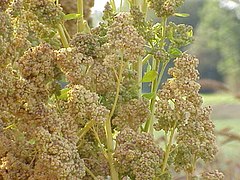Romaine lettuce
Comment: This week we will be enjoying Romain lettuce. Our kids love salad, and this week we will make salads with all kinds of additives like cheese and other vegetables and cereals. 
Not all lettuce is created equal, but if you start your meal with a salad made of romaine lettuce you will be sure to add not only a variety of textures and flavors to your meal but an enormous amount of nutritional value. Most of the domestic U.S. harvest of romaine lettuce and other salad greens comes from California and is available throughout the year.
Lettuce is synonymous with salads as they are predominantly made from crispy green lettuce leaves. Most varieties of lettuce exude small amounts of a white, milky liquid when their leaves are broken. This “milk” gives lettuce its slightly bitter flavor and its scientific name, Lactuca sativa derived from the Latin word for milk.
- Health Benefits
- Description
- History
- How to Select and Store
- How to Enjoy
- Safety
- Nutritional Profile
- References
Want to maximize the health benefits of your salads? Start with romaine lettuce for a salad guaranteed to be packed with nutrients. The vitamins, minerals, phytonutrients and fiber found in romaine lettuce are especially good for the prevention or alleviation of many common health complaints.
Due to its extremely low calorie content and high water volume, romaine lettuce —while often overlooked in the nutrition world—is actually a very nutritious food. Based on its nutrient richness, our food ranking system qualified it as an excellent source of vitamin A (notably through its concentration of the pro-vitamin A carotenoid, beta-carotene), vitamin K, folate, vitamin C, manganese, and chromium. Romaine lettuce also emerged from our ranking system as a very good source of dietary fiber and 6 vitamins and minerals.
Salad Days Keep Your Heart Young
Romaine’s vitamin C and beta-carotene content make it a heart-healthy green. Vitamin C and beta-carotene work together to prevent the oxidation of cholesterol. When cholesterol becomes oxidized, it becomes sticky and starts to build up in the artery walls forming plaques. If these plaques become too large, they can block off blood flow or break, causing a clot that triggers a heart attack or stroke. The fiber in Romaine lettuce adds another plus in its column of heart-healthy effects. In the colon, fiber binds to bile salts and removes them from the body. This forces the body to make more bile, which is helpful because it must break down cholesterol to do so. This is just one way in which fiber is able to lower high cholesterol levels.
Equally beneficial to heart health is Romaine’s folic acid content. This B vitamin is needed by the body to convert a damaging chemical called homocysteine into other, benign substances. If not converted, homocysteine can directly damage blood vessels, thus greatly increasing the risk of heart attack and stroke. In addition, romaine lettuce is a very good source of potassium, which has been shown in numerous studies to be useful in lowering high blood pressure, another risk factor for heart disease. With its folic acid, vitamin C, beta-carotene, potassium, and fiber content, romaine lettuce can significantly contribute to a heart-healthy diet.
The words lettuce and salad are practically interchangeable since most salads are made predominantly with the green crispy leaves of lettuce. Most varieties of lettuce exude small amounts of a white, milky liquid when their leaves are broken. This “milk” gives lettuce its slightly bitter flavor and its scientific name, Lactuca sativa since Lactuca is derived from the Latin word for milk.
Lettuce can be classified into various categories with the most common being:
- Romaine: Also known as Cos, this variety of head forming lettuce has deep green, long leaves with a crisp texture and deep taste.
- Crisphead: With green leaves on the outside and whitish ones on the inside, this variety of head lettuce has a crisp texture and a watery, mild taste. The best known variety of crisphead lettuce is iceberg.
- Butterhead: These types of lettuce feature tender large leaves that form a loosely arranged head that is easily separated from the stem, a sweet flavor and a soft texture. The best known varieties of Butterhead lettuce include Boston and Bibb.
- Leaf: Featuring broad, curly leaf varieties that are green and/or red, the leaf lettuces offer a delicate taste and a mildly crispy texture. Best known varieties of leaf lettuce include green leaf and red leaf.
While vegetables such as arugula, watercress and mizuna are not technically lettuce, these greens are often used interchangeably with lettuces in salads.
Native to the eastern Mediterranean region and western Asia, lettuce has a long and distinguished history. With depictions appearing in ancient Egyptian tombs, the cultivation of lettuce is thought to date back to at least 4500 BC. The ancient Greeks and Romans held lettuce in high regard both as a food and for its therapeutic medicinal properties.
In China, where lettuce has been growing since the 5th century, lettuce represents good luck. It is served on birthdays, New Year’s Day and other special occasions. Christopher Columbus introduced varieties of lettuce to North America during his second voyage in 1493. Lettuce was first planted in California, the lettuce capital of the United States, by the Spanish missionaries in the 17th century. Its popularity across the US did not become widespread until centuries later with the development of refrigeration and railway transportation.
Regardless of the type, all lettuces should feature crisp looking, unwilted leaves that are free of dark or slimy spots. In addition, the leaves’ edges should be free of brown or yellow discoloration. Lettuces such as Romaine and Boston should have compact heads and stem ends that are not too brown.
Since different types of lettuce have different qualities, different methods should be used when storing. Romaine and leaf lettuce should be washed and dried before storing in the refrigerator to remove their excess moisture, while Boston lettuce need not be washed before storing. A salad spinner can be very helpful in the drying of lettuce (and other salad ingredients as well). These lettuces should be either stored in a plastic bag or wrapped in a damp cloth and stored in the refrigerator crisper.
To store arugula, watercress and other types of salad greens that are sold with their roots attached, wrap the roots in a damp paper towel and place the entire greens in a plastic bag.
Romaine lettuce will keep for five to seven days, Boston and leaf lettuce for two to three days, while fragile greens such as arugula and watercress ideally should be prepared the day of purchase. All types of lettuce should be stored away from ethylene-producing fruits, such as apples, bananas and pears, since they will cause the lettuce leaves to brown.
For some of our favorite recipes, click Recipes.
Tips for Preparing Lettuce:
To clean lettuce, first remove the outer leaves and with one slice cut off the tips of the lettuce since they tend to be bitter. Chop the remaining lettuce to the desired size and discard the bottom root portion. Rinse and pat dry or use a salad spinner if you have one available to remove the excess water.
Wash greens such as arugula and watercress like you would spinach. Trim their roots and separate the leaves, placing them in a large bowl of tepid water and swishing them around with your hands. This will allow any sand to become dislodged. Remove the leaves from the water, empty the bowl, refill with clean water and repeat this process until no dirt remains in the water (usually two or three times will do the trick). Make sure your leaves are spun or patted dry before adding dressing so as not to dilute flavor.
A Few Quick Serving Ideas:
Give sandwiches extra crunch (and nutrients) by garnishing with lettuce leaves.
When it comes to salads, the only limitation is your imagination. Be creative: use a variety of different lettuce types and add your favorite foods. Whether they’re vegetables, fruits, seeds, nuts, whole grains, whole wheat croutons, soy products, meats or cheeses, most every food goes well with lettuce.
For an interactive meal that is both unusual and fun, arrange nuts, diced vegetables, chicken and/or baked tofu and romaine lettuce leaves on a large plate. Everyone then has the chance to make their own lettuce pockets by placing their favorite fillings in a lettuce leaf and making a breadless sandwich wrap.









